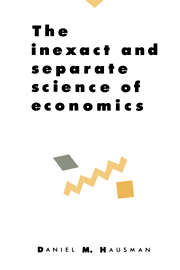Book contents
- Frontmatter
- Contents
- List of figures
- Dedication
- Introduction
- Part I Introduction, structure, and strategy
- 1 Rationality and utility theory
- 2 Demand and consumer choice
- 3 The theory of the firm and general equilibrium
- 4 Equilibrium theory and economic welfare
- 5 Models and theories in economics
- 6 The structure and strategy of economics
- 7 Overlapping generations: a case study
- Part II Theory assessment
- Part III Conclusion
- Appendix: An introduction to philosophy of science
- Bibliography
- Index
3 - The theory of the firm and general equilibrium
Published online by Cambridge University Press: 04 August 2010
- Frontmatter
- Contents
- List of figures
- Dedication
- Introduction
- Part I Introduction, structure, and strategy
- 1 Rationality and utility theory
- 2 Demand and consumer choice
- 3 The theory of the firm and general equilibrium
- 4 Equilibrium theory and economic welfare
- 5 Models and theories in economics
- 6 The structure and strategy of economics
- 7 Overlapping generations: a case study
- Part II Theory assessment
- Part III Conclusion
- Appendix: An introduction to philosophy of science
- Bibliography
- Index
Summary
Consumer choice theory purports to explain and to predict the demand “side” of markets, but an understanding of competitive economies also requires a theory of supply. And a theory is also needed concerning how the “forces” of supply and demand jointly determine economic outcomes. In this chapter I shall fill in these remaining pieces of positive microeconomic theory, before turning in chapter 4 to the normative theory of economic welfare. The material here – especially in the first four sections – should again be familiar to economists, but there are controversial claims in the last three sections, which should not be skipped.
Market supply of consumption goods and the theory of the firm
Just as market demand depends on prices, incomes, and tastes, so market supply depends on prices and technology. A higher price for x brings forth a larger supply; a lower price discourages supply. Some copper mines, for example, were closed completely when the price of copper dropped in the 1970s. Higher prices of inputs either increase the price of output or decrease its supply. Improvements in technology can make it cheaper to produce something and will increase the supply of it at a given price.
As in the case of generalizations concerning demand, empirical work and statistical analysis can add a quantitative dimension; and the results can be of practical use.
- Type
- Chapter
- Information
- The Inexact and Separate Science of Economics , pp. 42 - 56Publisher: Cambridge University PressPrint publication year: 1992



